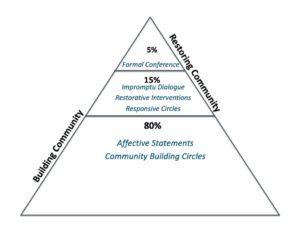by Paul Osincup, Restorative Practices Trainer, Community Matters
One of the first questions I ask administrators and teachers when I facilitate trainings on restorative practices is how much experience they have with it or what they know about it. After working with educators in school districts all over the country, here are three things that are consistent everywhere I go:
- Administrators and teachers are always open to learn about strategies that will help them decrease classroom disruption and increase social responsibility and inclusivity.
- When I first mention restorative practices, many people in the room think I’m only talking about restorative justice.
- Educators are predisposed to “initiative fatigue” and don’t want this to be just another thing to add to their plate.
Restorative Justice (RJ) is a formal process where a person who has caused harm to an individual or group has the opportunity to meet with those who have been harmed or affected. They create a shared agreement about how the offender can repair the harm and all parties can reintegrate and move forward. RJ is used in the criminal justice system as well as at some colleges and universities and K-12 schools in conjunction with traditional disciplinary procedures.
Restorative Practices (RP) according to Ted Wachtel, Founder of the International Institute for Restorative Practices, RP is “…a social science that studies how to build social capital and achieve social discipline through participatory learning and decision-making.”
The simplest way to understand it is that restorative practices involves a continuum of interventions and strategies that are both proactive and responsive. Restorative Justice is ultimately a subset of restorative practices and is primarily only responsive in nature. On the continuum below, RJ would be considered a form of “Formal Conference” on the right.

Proactive RP Strategies:
- Strengthen Relationships
- Build Trust
- Develop Community
Responsive RP Strategies:
- Manage Conflict and Misbehavior
- Meet Needs/Repair Harm
- Restore Relationships
At Community Matters, we know it’s crucial to have evidence-based strategies to respond to disruptive behavior, and we also know that prioritizing relationships and connections creates a community where students develop a sense of social discipline resulting in less disruptive incidents to respond to.
So, how does it all work?
Well, that usually takes us two full days to explain but I can at least give you some proactive and responsive examples based on the RP continuum. For example, classroom circles (second from the right on the continuum) can be used proactively or in response to an incident.
A teacher who’s trained to facilitate classroom community building circles will use circle guidelines, a talking piece, engaging prompts, and activities to help students get to know one another personally throughout the year and create meaningful connections with their classmates. Once these connections are established and the kids begin to develop trust with each other and a familiarity with using circles to speak honestly and listen actively, that same teacher may choose to use a circle to respond to an issue. For instance, she may ask the students to respond to a note she received that the class was not good for the substitute the day before.
Ideally, about 80% of the RP work that is being done in the school is to build community to foster a positive school climate, while 15 – 20% is responsive in nature.
Whether I’m facilitating a workshop focused more on community building and the proactive side of things or on facilitating formal conferences to respond to student behavior, I’ve found it’s important to remind the participants that restorative practices is not a separate curriculum or initiative designed to replace your current curricular, behavioral intervention, or disciplinary models. Rather, RP is a way of being. It’s a tool to enhance your current practices, and a catalyst for youth voice. As a former Associate Dean of Students and university disciplinary officer, I understand the overwhelm and “initiative fatigue” that happens when we’re given a new program or curriculum to add to our plate. What I love about restorative practices, however, is that it’s really just a collection of tools you can incorporate into your school culture as you see fit.
Restorative practices help kids learn the basic skills it takes to be a member of a community, like empathy, listening, and conflict resolution, so it’s easier for you to teach them more complex skills like reading, writing, and math. Reclaiming the role of relationships and connection in schools isn’t just another thing to add to our plate… it is the plate.
